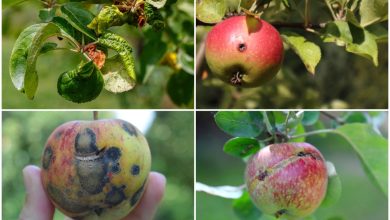Plant Potatoes: The Complete Guide to do it [Step by Step]
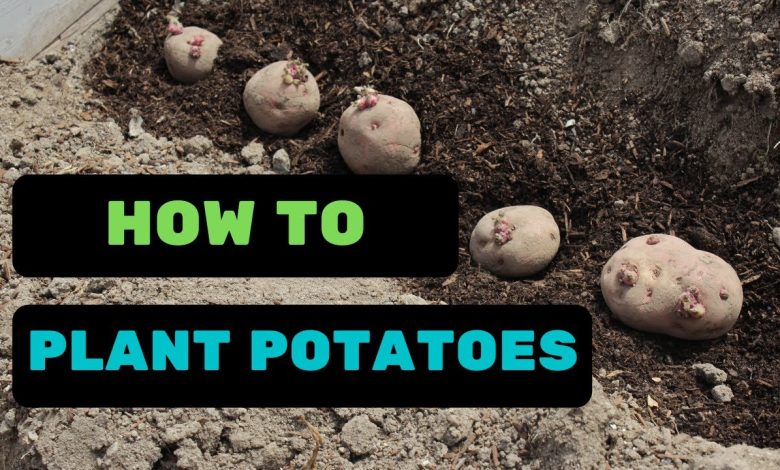
You will agree that:
The potato is for everything.Together with the tomato, it is probably one of the most used foods in all cultures.
But… How can I improve its taste? eitherAvoid having PESTICIDES, chemicals or other additives?
Growing them yourself. That is all.
It’s hard?No. No yesfollow these stepswhich we indicate below.
It will take you a maximum of (10 minutes) to read this article, but I assure you that later you will have much more clarity on how to plant potatoes.
Important Points for Planting Potatoes:
- When? In Spring, ideal end of March and beginning of April.
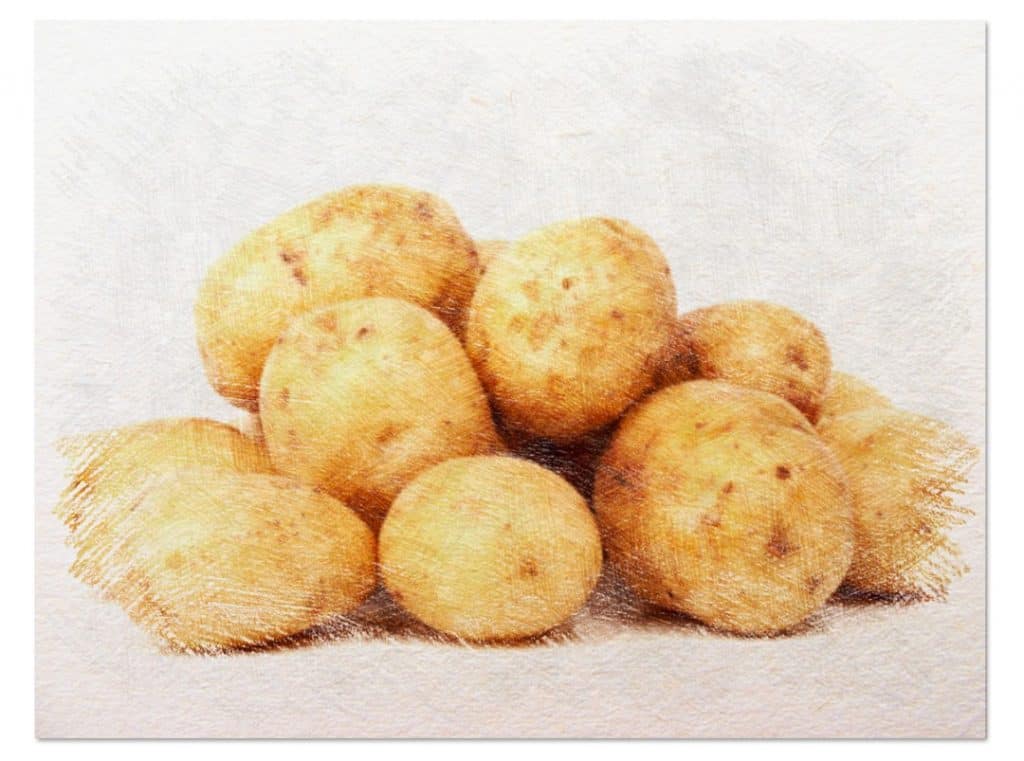
- Where? Place of maximum sun exposure.
- Harvest time? Depending on the variety, it can be from 75 to 200 days.
- How? Through selected seeds or tubers for sowing. Also cutting half a potato and depositing the cut part face down (touching the ground).
- How do we prepare the land? Tilling, aerated and fertilized with animal manure (ideal). We make ridges.
- At what distance do we plant them? Between 70 and 80cm.
- How do we water? Ideal drip irrigation. Moderate but constant water.
- How often do we water? It depends on the heat, but in summer daily. spring and autumn every 3-4 days. 45 minutes.
- What do we plant next? Lettuce, garlic, thyme, chamomile, onion, chives.
- What do we NOT plant next to it? Carrots and onions.
- What diseases and pests do they have? Aphids, potato beetle, whitefly, red spider mite and potato tuber moth.
- When can we collect? When the stems dry and take on a yellowish color. At 60-90 days from sowing (depending on the variety).
Planting Potatoes Step by step [12 Steps]
- Space with sufficiently fertilized land.
- Water available for irrigation.
- Direct sunlight most hours of the day.
- Certified seeds (give better results) of the variety you want to plant.
- A little time, desire and perseverance.
- We remove the soil and clean it of weeds.
- It is ideal to leave the soil well tilled so that it drains easily.
- We will generously fertilize the land, either with animal manure, earthworm humus or compost (to learn more about potato fertilizer).
- We will leave between 70 and 80cmfrom one plant to another in case of planting in the orchard and about 40cm distance between the ridges or planting lines.
- The traditional way of growing potatoes is to introduce one or two pieces 12cm deep, with the eye of the potato facing outwards (up).
- We will install a drip irrigation system to water constantly, but avoiding waterlogging.
- We will water every two days in the hottest months (30-40 minutes) and in the least hot months we will space the irrigation to 1 or 2 times a week.
Potatoes are one of the most appreciated tubers, like yams or ginger, in the kitchen today. Not only their flavor makes them versatile and queens

vegetarian of endless dishes, but their variable cooking methods cause them to change in texture, color and shape.
As if that were not enough, they have found life in dishes of all levels. From the delicious and popular French fries (fried potatoes) that we eat as a snack or accompaniment in any fast food establishment; to the most sophisticated preparations in a restaurant that are found in mashed potatoes and baked potatoes, gastronomic allies as a garnish for practically any main dish.
In addition to their aforementioned fame and gastronomic versatility, they replicate these virtues within home gardens, being easy to grow and extremely popular with all planting enthusiasts (both small and large).
That is why, if your goal is to plant potatoes, you are in luck. Next we will tell you in detail how to enjoy organic potatoes, fresh and ready to enjoy at your table(with a flavor that will surprise you compared to supermarket potatoes).
Did you know…In 1995, the potato was the first food grown in space. Also, in the science fiction movie and book «The Martian», astronaut botanist Mark Watney starts growing potatoes on Mars to survive until a rescue mission arrives.
If you like potatoes as much as we do, and you want to enjoy their benefits in a controlled sowing (without pesticides, questionable seeds or soil treatments) then you should consider the option of planting potatoes in your own garden.
Potatoes are not only excellent for planting in any corner of your garden or orchard, but they do very well in pots, and there are some specific ones for them.
How to plant potatoes?
Growing potatoes doesn’t have to be complicated.
The first thing you must determine is if you have the appropriate spaces for planting and if you are at the right time to do the task.
They need direct sunlight, so whether you have them on your balcony, terrace or garden, you should find an exact spot where the sun hits them all day. So what do we need?
- Space with sufficiently fertilized land.
- Water available for irrigation.
- Direct sunlight most hours of the day.
- Seeds or tubers for planting the variety you want to plant.
- A little time, desire and perseverance.

Did you know…The potato is the fourth most cultivated food, behind wheat, corn and rice.
How far apart do I plant the potatoes?
Like all tubers (sweet potato, yam, cassava…), their roots are wide and aggressive, so they must have a good space (width and depth) available, or failing that, a pot with the correct dimensions.
If you are going to plant them in the ground, you should know that they must be changed places every 3 years (that is, if you plan to make this planting an annual routine, you must prepare 3 different places).
If, on the other hand, the planting is in a container, you should not worry, you will only have to renew the soil every time you plant again.
We must leave between 70 and 80cmfrom one plant to another in case of planting in the orchard and about 40cm distance between the ridges or planting lines.
When should I plant potatoes?
Potatoes require a cool environment (not winter) so the best time to plant them is early spring.
If you live in tropical countries, the ideal is to opt for the rainy season, when the environment is cooler and more humid for its development.
If you wait for spring, make sure it’s a time when you don’t have any upcoming unexpected frosts (ie below 7 degrees).
End of March and beginning of April, depending on the temperature, are usually good dates to start planting in our garden.
You can plant potatoes in other seasons.
If, for example, you plan to save your potatoes for the winter, you could plant them in the middle of June, to collect them before the cold starts.
Their ideal neighbors: What do we plant next to them?
 If you have a mixed garden in your garden and you want to add potatoes or give them a certain prominence without losing the opportunity to take advantage of your space for other plantations, it is necessary to think about which neighbors would be the ideal ones for your potatoes.
If you have a mixed garden in your garden and you want to add potatoes or give them a certain prominence without losing the opportunity to take advantage of your space for other plantations, it is necessary to think about which neighbors would be the ideal ones for your potatoes.
Understanding that they are a plant with very aggressive roots, the ideal is to surround them (at a preventive distance as well) with other less invasive plants at ground level, that is, with short roots and whose growth is rather exponential upwards.
Lettuce, spinach, chives and leeks are good companions for potatoes, as their roots are shallow and their soil and water requirements are similar.
Some medicinal or aromatic herbs are said to improve the taste of potatoes (as well as serving as organic herbicides for your garden in many cases). The best known are basil, chamomile, parsley and thyme.
Cauliflower, beans and corn can also be important allies for potatoes during their growth.
Trick:
In the case of legumes, they raise the nitrogen levels of the soil where they are found, so they make good companions for other vegetables, which is why many call them the «universal donors».
Garlic are also good neighbors. turn out to bea very effective natural anti-insect toolMost of the time.

Remember to design your home garden before starting to plant, develop a planting calendar and plan how long it will take you to see the fruit of each of your vegetables, spices and tubers.
A good fertilizer is leachate. Did you know…Potatoes were first cultivated by the Incas in ancient Peru before the arrival of Columbus. They quickly spread throughout Europe, Asia and North America, one of its main producers today (more than 40 billion kilos of annual production).
What should we NOT plant near the potatoes?
 Not all is rosy in garden life though, some plants really should be ignored when it comes to company for your potatoes.
Not all is rosy in garden life though, some plants really should be ignored when it comes to company for your potatoes.
“Night” plants are the first toxic companions that you should avoid for your potatoes, such as aubergines, since they share the same diseases as potatoes and therefore create a very weak environment that attracts the same viruses, bacteria and insects.
Other plants, on the contrary, seem to naturally increase pests in potatoes, such as cucumbers, raspberries, sunflowers, and pumpkins, which are also invasive although at ground level.
And some plants, such as carrots, asparagus, and onions, inhibit the proper growth and development of potatoes, all of which grow similarly and thus drown each other out in space.
What do we need to grow potatoes?
If you have enough space
If you have a more or less large area and enough land, get a hoe or better yet, a motorized hoe would be ideal to prepare the land.
These tools, especially the motoazade or motocultor, will help you a lot when it comes to removing the earth and aerating it.
After having passed it at least once in the area where you want to plant the potatoes, we will add the compost and organic matter such as manure and stir again so that it is well mixed with the soil.
Now the area is beginning to be prepared, but it’s time to have the ridges.
The tiller will help you a lot when you have passed it several times. Letting her walk little by little on the ground, she will make the ridges herself without you noticing.
 If you do not have a motorcycle, it will take a little more work. But with a hoe it is also possible to prepare the ridges.
If you do not have a motorcycle, it will take a little more work. But with a hoe it is also possible to prepare the ridges.
Once you are sure that you have all the requirements that your potatoes ask for to develop, it is the ideal time to prepare the ground.
Potatoes are fortunately not very picky about the soil.
Our experience tells us that they require slightly acid environments (5.8 – 6.5) but can tolerate different ranges. They are extremely grateful!
The important thing is to maintain good levels of organic matter in the soil. To see prepared a good bucket of compost beforehand is ideal.
You must also keep the soil moist, without saturating it with water, otherwise you could quickly rot the roots of the potatoes.
The ideal is to get certified seeds to work, however, you can use any «born» potato that you have in your kitchen, assuming greater risks in terms of growth and harvest.
The results are usually very similar if proper care is taken.
How do we water the potatoes?
There are many mechanisms, but weWe recommend drip irrigation.The reasons are several, among them:
- You can schedule watering every day a couple of times.
- It saves a lot of water. Irrigation is more efficient.
- Moisture penetrates better and therefore stays better on the ground.
- Weeds are better controlled as the irrigation is very focused.
What is called «seeds» is not exactly that, from each «eye» the potatoes begin to develop roots, as often happens with potatoes that already have some time in our pantries.

When the first sprouts have come out, we must cut the potatoes with clean and straight cuts, leaving a minimum of 2 sprouts in each piece. Once cut, we will extend them in a dry place and without much light for a few days so that the cut heals and they sprout before planting them.
You will see that the plants will grow as long as you maintain constant watering and have sunlight.
Generally, you can plant a whole born potato, or with the more traditional techniques, cut into pieces that have 1 or 2 eyes (roots) in each one, distributing them in the soil about 12 centimeters deep and covering them with loose soil.
Therefore, we will take our tubers, we will make a clean cut forming two or three pieces (depending on your eyes) and we will plant them in fertilized, moist soil with space.
If you don’t have much space…
As for pot planting, you can choose to use a large pot or even a tall dumpster or whiskey barrel; leaving a layer of soil of about 20 centimeters at the base, placing your seeds or tubers and filling with soil as the plant develops.
The advantage of this system is that it does not require a lot of space and you can implement it in your urban garden without any problem.
The little seeds will start to develop into the main stem of the plant which will branch out and there will start to be multiple brutes and stems (There’s our plant!).
This will indicate that under the ground the stage for the creation of new potatoes is beginning to develop.
We cannot constantly dig up our potatoes to verify their development, it is necessary to pay attention to the health of the plant, since as the saying goes “Where there is no bush, there is no potato”.
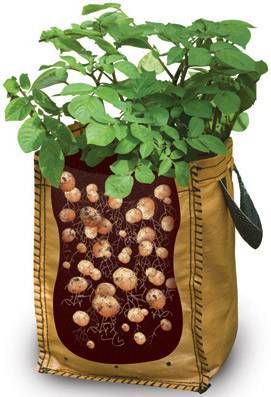
Tips to take care of my potatoes
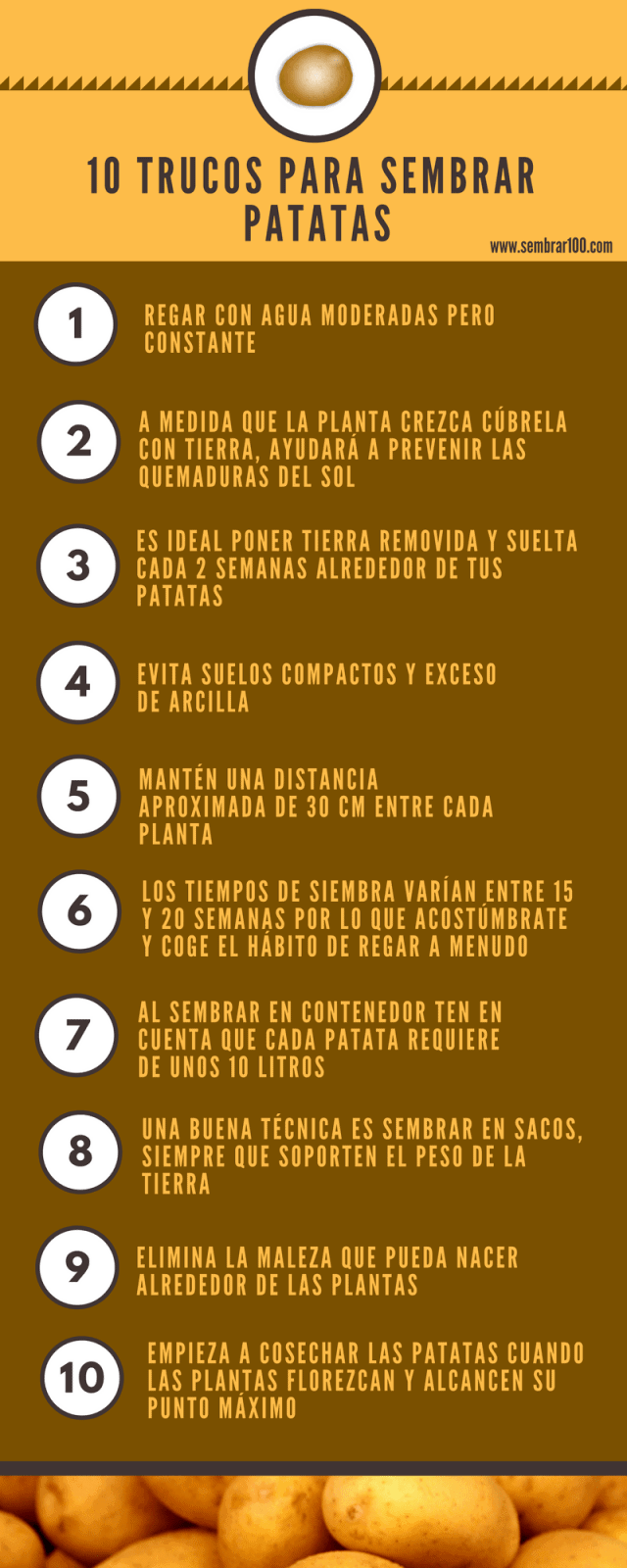
Potatoes are not particularly delicate, so their care is few. However, they should not be taken lightly, and some basic instructions need to be followed, including:
Water with moderate but constant waterEspecially when silver begins to develop, the ideal is to water moderately every day, to maintain soil moisture.As your plant grows, cover it with soil and help prevent sunburn.Those burns can give your potatoes a greenish tint, a sign that they’re producing a chemical called solanine. Solanine gives potatoes a bitter taste and makes them potentially toxic, so you should avoid eating green potatoes.As your plant grows, cover it with soil and help prevent sunburn.Those burns can give your potatoes a greenish tint, a sign that they’re producing a chemical called solanine. Solanine gives potatoes a bitter taste and makes them potentially toxic, so you should avoid eating green potatoes.Ideally, put loose soil on your potatoes every 2 weeks.Approximately, and thus avoid problems associated with the sun or lack of nutrients.Avoid compact soils and excess clayThis causes the potatoes to grow smaller and drown.Potato formation begins when the soil is coolAt about 15 degrees and weakens when the ground reaches 25-30 degrees, already at the beginning of summer.Keep a distance of about 30 cmBetween your potatoes in line and up to 70 cm between the vegetable line.Planting times vary between 15 and 20 weeksSo at that time you must create the habit of irrigation and coverage.When planting in a container, keep in mind that each potato requires approximately 10 litersSo you should look for a container of equal or greater size.Another good technique is to sow in sacksMaking sure that they support the weight of the soil needed at the time of sowing and the one that you will add during growth.Eliminate the weeds that can be born around the plantsDo not water abundantly before harvesting, to avoid rotting the tubers.Remove the potatoes from the groundThe instant they reach their peak of development.
Most common diseases of potatoes
Potatoes are also prone to some diseases that can destroy your entire plantation.
Some insects are as fanatical about potatoes as we are, and we must take care of our crops to have previous guests at our table.
What insects affect them the most?
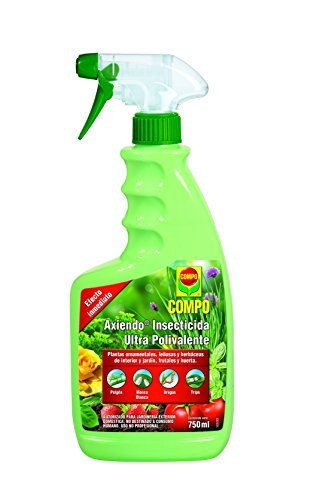 Some creeping commensals are quite frequent in our potato crops, some of the most common are aphids, potato beetle, whitefly, red spider mite, wireworm and potato tuber moth.
Some creeping commensals are quite frequent in our potato crops, some of the most common are aphids, potato beetle, whitefly, red spider mite, wireworm and potato tuber moth.
potato beetle
One of the most voracious beetles is the potato beetle, with the scientific name Leptinotarsa decemlineata and belonging to the Chrysomelidae family.
It is a species that has managed to conquer practically the entire world thanks to its aggressive behavior, which makes it a very dangerous pest for one of the most consumed tubers worldwide: the potato, both in the field and in storage.
To know more: Fight and detect the potato beetle.
La presencia de estos indeseables bichos es fácilmente detectable: hojas roídas, pequeñas telarañas, agujeros en los tubérculos, tono amarillento en las hojas y la indiscutible presencia de pequeños puntos blancos (las moscas) nos darán el llamado de alerta: no estamos solos con nuestras patatas
Pueden erradicarse con relativa facilidad, buscando idealmente un insecticida orgánico de amplio espectro o específico para cada peste una vez esté identificada.
Existen también poderosos químicos para erradicarlos, pero no son los más recomendables para productos de consumo (por más seguros que garanticen ser)
También es importante tomar en cuenta las recomendaciones anteriormente hechas sobre los vecinos más adecuados para nuestras patatas, muchos ayudarán a combatir las plagas y a evitar tener que recurrir a insecticidas y pesticidas potencialmente tóxicos.
¿Cuáles son las enfermedades más comunes de las patatas?
Las patatas también pueden enfermarse, bien sea por problemas de suelo, agua, o simplemente mala genética del tubérculo. Algunas de las más frecuentes son:
- Negrón de la patata: Es fácilmente identificable por manchas pardas circulares que forman aros o anillos en crecimiento (similares a los de un tronco de árbol) también en los bordes parecen arrugar o secar las hojas.
- Viruela de la patata: notarás lesiones oscuras en las patatas, los tubérculos desarrollan pústulas de color oscuro, manchas negras y presentan un color de base blanquecino, de tener viruela, es necesario identificar la extensión de la enfermedad y desechar la cosecha de ser necesario.
- Mildiu: Una enfermedad que se caracteriza por desanimar a la planta, quemándola por focos localizados y al abrir una patata, podrás encontrará surcos marrones y una sensación similar a la de podredumbre, si es localizada a tiempo pueden retirarse las partes infectadas y salvar la cosecha.
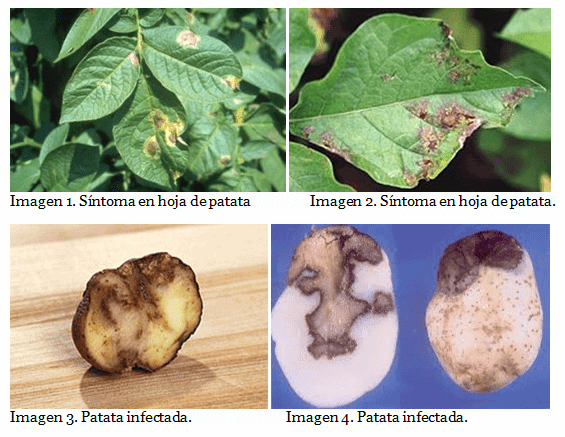

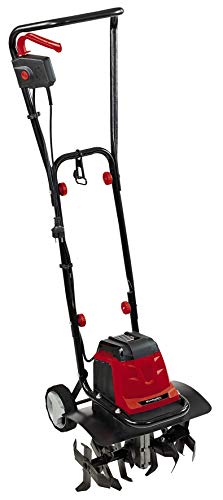
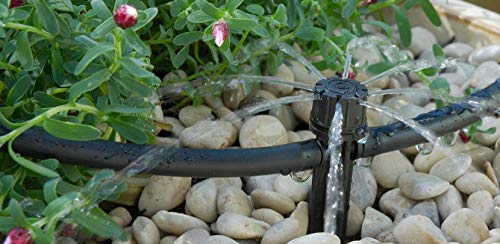
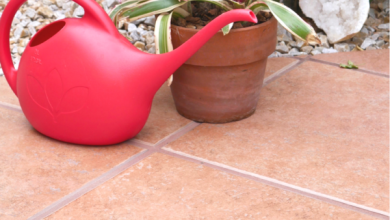
![Photo of Aglaonema: [Care, Planting, Irrigation, Substrate and Characteristics]](https://www.complete-gardening.com/wp-content/uploads/2022/08/aglaonema-care-planting-irrigation-substrate-and-characteristics-390x220.jpg)
![Photo of Plant Leeks: When, How, Where and much more [12 Steps]](https://www.complete-gardening.com/wp-content/uploads/2022/08/plant-leeks-when-how-where-and-much-more-12-steps-390x220.jpg)
